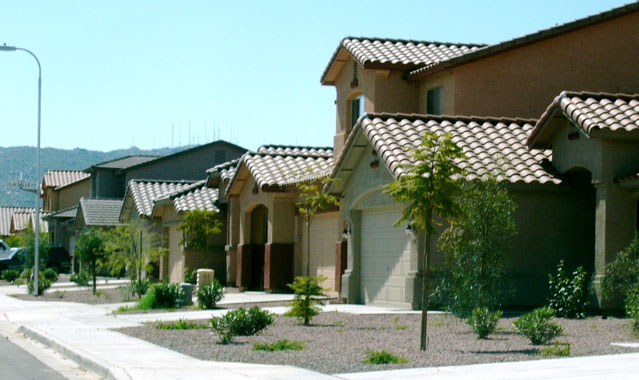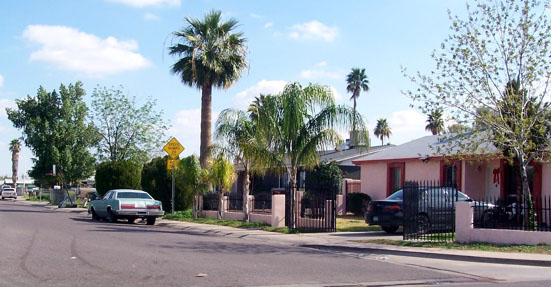|
|
|
| Chris Brown's Project Pages
|
A Village Divided By Chris Brown Standing just north of the intersection of Southern Avenue and 11th Street in South Phoenix, a poignant picture develops. Looking north, downtown Phoenix, with its skyscrapers and sports stadiums, looms over the area with the promise of progress and development. To the left is a new subdivision of houses, built since 2002. A wall surrounds the development, satellite dishes and uniformly colored two story houses peering over as if to drown any doubt in your mind that growth may yet not have arrived. To the right, however, houses built in the fifties and sixties prominently display unkempt yards and fading paint in a multitude of passionate colors. The stark difference between these two communities is hard to miss, and denotes a greater contrast emerging in the area.
New housing and business, fed by recent gentrification, increasingly displace people who have called South Phoenix home for generations. Within a few years, scenes such as this may be hard to find. Gated communities and strip malls may have replaced all that is left of the older developments, making “South Mountain Village” a haven for white, middle class Phoenicians. Until then, it is important to note the differences between these sharply contrasting communities, speaking to the greater differences and changes quickly becoming a part of the area. Only with this knowledge can we begin to answer questions as to the significance of what is lost and gained in this transition, and only after posing and responding to such questions can we truly learn about the society we live in. The new housing development is evidently unnamed, consisting of one-hundred to one-hundred and fifty tract homes surrounded by a wall. It is not a gated community, but the impeccably maintained community areas of grass and plants, front yards, and similarly colored houses all serve as evidence to a home owners association and “community” based decisions. All of the few people we saw were white, a fact not surprising considering what social and economic groups are moving into houses such as these one and two story clones. Lots and homes were of medium size, with well maintained desert and grass front yards containing no art or house ornamentation. Community mailboxes occasionally stand beside the road, taking even more chance for individual expression away from home owners. The whole neighborhood feels like a fortress, with strict leadership laying out rules for everyone living within the wall, stifling any voice of individuality.
Newer communities such as this one seem to speak of a specific social class, content with remaining mostly in private worlds. Cars are rarely parked on the streets. Home owners never have to set foot outside their own personal world, traveling from house to the car parked in the two car garage to the office and back again to their satellite television. Perhaps the striking lack of individuality in these neighborhoods helps people lacking social contact feel like part of a larger community. A sense of belonging stems from seeing a small group of homes built just like yours, painted and ornamented just like yours, landscaped just like yours, and inhabited by people who must be just like you. Perhaps people need to feel this comfort when they come home, and modern housing developments can provide that comfort built-in, without the need to spend the time and energy necessary to belong to a community based on friendships and interaction. Or perhaps people just like living where they know what is going to happen. The older subdivision, named “South Vistas,” contains homes obviously built before the 1970s. No walls, except those of the surrounding newer subdivisions, mark the neighborhood, and although the houses were originally tract homes, several notable houses have been remodeled. The houses all serve as individual expressions of their mostly minority owners. House colors are widely varied and often bright, and front-yard enclosures are pervasive, ranging from short, unadorned fences to grand yet cheap iron gates. The houses are of medium size and sit on similarly sized lots, with front lawns and houses often adorned with ornaments or art. Strikingly, the state of landscaping in the neighborhood ranges widely, but mostly seems neglected to some degree. Even with these unkempt front yards and cars parked in front of seemingly every house, chairs sit in the front yards of most homes. People in this neighborhood obviously spend a significant amount of time in front of their house, a stark contrast to the new subdivision just over the wall.
Image seems to matter little to the people of this community. Poorly kept landscaping and houses do not hide the laundry drying in the back yard or the cars parked in the streets. People make little effort to look like everyone else, but seem to make an effort to get to know each other. By sitting in front of their homes, showing their every-day activities such as laundry, and displaying their lives for their neighbors to see, the people in this community are communicating and becoming acquainted. Instead of gaining a sense of belonging by conforming to a norm, they have chosen to be a part of a community based on social interaction. In “Residential Subdivision Identity in Metropolitan Phoenix” by Kevin Blake and Daniel Arreola, the differences in how people who live in different kinds of subdivisions, such as the two kinds I have explored above, develop and express an identity are explored. Through a much more detailed and specific method of gathering information about a development’s attributes, Blake and Arreola discover how new subdivisions, often described as lacking identity, actually allow residents to express a form of identity that has been often overlooked. Through “personal signatures” and projected identities such as walls and turf markers that are “both a symbolic and material effort to control social interactions,” modern subdivisions allow for identity, even if it is expressed in a different manner than in older, often more superficially differentiated communities. (34) I have briefly explored in this essay two distinct modes of creating a community. Each succeeds in creating a sense of belonging, and each is practiced by separate social and economic groups of people. I mean to cast no judgment concerning the superiority, moral or otherwise, of one over the other, but understanding the differences can help explain the changes and conflict occurring in South Phoenix. As two groups of people, accustom to expressing themselves in different ways, come into contact, conflict is bound to occur. As South Phoenix continues to develop into “South Mountain Village” we may see more of this clash. Hopefully, with the help of a little perspective, this conflict will be of a positive nature, generating new cultural and social expression, and adding to the uniqueness of a historically vibrant area.
|



